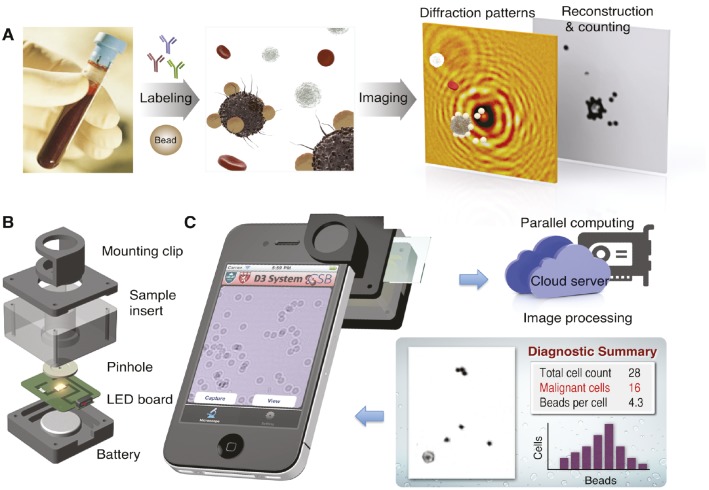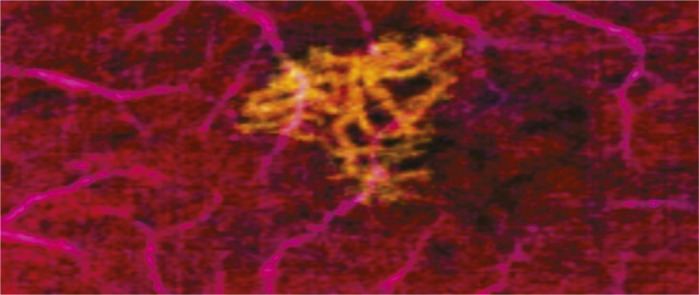Rapid cancer diagnosis through diffraction analysis
Digital diffraction diagnosis platform.
Digital holography can help perform rapid, reliable, and unencumbered cancer diagnosis at points of care, particularly in resource-poor settings. Hyungsoon Im et al. (pp. 5613–5618) developed an assay called “digital diffraction diagnosis” based on computational analysis of diffraction patterns of molecularly tagged beads that bind to cancer markers found in patient samples. A plastic module fitted with a light source, minilens, and sample insert was snapped snugly atop the camera of a smartphone, which recorded and uploaded patterns from the beads to a remote server, furnishing a preliminary diagnosis within 45 minutes. The authors tested the assay’s utility for cervical cancer screening and human papillomavirus (HPV) detection. Using beads that bind to cells labeled with antibodies against cervical cancer-associated markers, the authors determined average bead counts per targeted cell (nbead) for cervical samples from 25 patients with abnormal Pap smears; the samples were separately identified through conventional pathology as “high risk,” “low risk,” or “benign.” Using nbead as a diagnostic parameter, the authors grouped the samples into high-risk versus low-risk/benign categories, with a sensitivity of 100% and specificity of 92%. The assay also helped detect atto-mole ranges of HPV DNA in patient samples. According to the authors, the assay, which currently costs $1.80 per diagnosis, demonstrates the feasibility of a smartphone-based diagnostic approach in resource-limited settings. — P.N.
Early adversity and development of stress responses
Studies in mice indicate that early exposure to adverse conditions can alter how the sympathetic nervous system responds to stress. To examine the effects of adversity on the human nervous system, Katie McLaughlin et al. (pp. 5637–5642) studied the development of abandoned children in Romania. The authors engaged 138 children in stressful tasks and collected ECG, impedance cardiograph, and neuroendocrine measurements to monitor how the autonomic nervous system (ANS) and the hypothalamic–pituitary–adrenal (HPA) axis respond to stress. Children who were raised in institutional care settings during early childhood displayed blunted responses of the sympathetic nervous system, a branch of the ANS associated with the fight-or-flight response, and the HPA axis during the tasks. In contrast, children removed from institutions and raised in foster homes displayed responses similar to those of a control group of children raised by their families. In addition, children placed with foster families before the age of 24 months displayed ANS and HPA axis responses that most closely resembled those of children who did not grow up in institutions. According to the authors, the results suggest that a child’s early care can influence development of the stress response system, which may be especially vulnerable during the first 24 months of development. — J.P.J.
Global antimicrobial use in livestock
Antimicrobial use in farms tied to antibiotic resistance. Image courtesy of iStockphoto/bizoo_n.
Around 80% of the antimicrobial compounds used every year in the United States can be attributed to livestock production, which relies on antibiotics to boost growth and prevent disease in food animals. Previous studies have suggested links between the use of antimicrobials and the increased prevalence of antibiotic-resistant bacteria in livestock. Thomas Van Boeckel et al. (pp. 5649–5654) used maps of livestock densities, projected demand for meat products, current estimates of antimicrobial use in high-income countries, and statistical modeling to estimate annual average antimicrobial use in livestock. The authors estimate that around 63,151 tons of antimicrobials were used for livestock production in 2010 by 228 countries, with China, United States, Brazil, India, and Germany topping the list. Compared with raising cattle, raising chickens and pigs each consumed a greater amount of antimicrobials. Further, global antimicrobial consumption is projected to increase by 67% by 2030, partly due to increasing demand for meat products and adoption of intensive farming practices in middle-income countries such as Brazil, India, and China. By 2030, antimicrobial use in those middle-income countries is estimated to reach almost twice their 2010 levels, far outstripping population growth. Despite the study’s requisite assumptions and extrapolations, quantitative estimates of antimicrobial use might help identify potential hotspots for the emergence of antibiotic resistance, according to the authors. — P.N.
Spatial variability of airborne microorganisms
Map showing the relative abundance of Cladosporium fungi in dust samples. Warm colors indicate high relative abundance.
Although the presence of bacteria and fungi in the atmosphere and the potential for long-distance atmospheric transport of microbes have been long known, the continent-scale spatial variation in microbial communities is poorly understood. To map airborne microbial diversity, Albert Barberán et al. (pp. 5756–5761) collected samples of dust from the exterior surfaces of more than 1,200 homes throughout the United States and assessed the bacterial and fungal species in the samples. Alphaproteobacteria was the dominant bacterial class, and Capnodiales and Pleosporales were the dominant fungal orders identified in dust samples. Although the microbial community composition displayed high spatial variability, coastal regions shared similar airborne communities, suggesting that climatic and soil factors might explain some of the variation. Cladosporium, a fungal genus and common allergen, was abundant in humid areas, such as the Midwest and eastern United States. Urban dust was not found to contain communities distinct from rural dust, but urban microbial communities exhibited less variability than rural communities, suggesting that urbanization may lead to homogenization of airborne microorganisms. The results suggest that information about the continental distribution of airborne microorganisms may help identify associations between airborne microbes and disease, according to the authors. — P.G.
Naturally transgenic sweet potato
Different sweet potato cultigens. Image courtesy of the International Potato Center (CIP).
Agrobacterium bacteria are common plant pathogens that possess the ability to transfer segments of their DNA to plants, a property also used by plant scientists to produce transgenic or genetically modified crops. Tina Kyndt, et al. (pp. 5844–5849) conducted genetic analyses on 291 samples of cultivated sweet potato plants (Ipomoea batatas) from the Americas, Africa, Asia, and Oceania, nine samples of wild I. batatas plants from the Americas, and four samples from three related Ipomoea species. The authors discovered the presence of two DNA regions from Agrobacterium species in the cultivated samples. One of the bacterial DNA regions coded for genes that were expressed at detectable levels in all 291 cultivated plant samples, but not in any of the wild plant samples. The other DNA region was found in 45 of 217 sweet potato genotypes examined, including both cultivated and wild species. Several of the genes are associated with biosynthesis and sensitivity to plant hormones. According to the authors, the results suggest that transgenic DNA may have arisen naturally in the sweet potato by horizontal gene transfer during infection by Agrobacterium and that the bacterial DNA may have provided traits that were selected for over thousands of years of domestication.— J.P.J.
Visualizing blood vessel abnormalities in living human eyes
OCT angiography of abnormal blood vessels (yellow), normal retinal vessels (pink), and choroidal vessels (red) in the choroid.
Diseases that affect retinal blood circulation are an important cause of blindness, and examining vascular abnormalities can help diagnose and treat such diseases. Optical coherence tomography (OCT), a technique used to image the retina, has limited ability to image blood vessels of the retina or the choroid—the region between the retina and the white of the eye. Yali Jia et al. (pp. E2395–E2402) developed an OCT angiography method that generates high-quality images of the blood vessels in both the retina and the choroid. The technique has several advantages over conventional dye-based techniques of visualizing blood vessels, including rapidity, obviated need for intravenous injections, and capability for 3D visualizations of blood vessels in the living human eye. The 3D nature of the technique allows separate visualizations of retinal and choroidal circulations from the same scan. The authors report results from six illustrative cases showing that the technique was able to detect vascular abnormalities in diseases such as diabetic retinopathy, age-related macular degeneration, and choroideremia. The technique could be used to noninvasively image blood vessels in 3D to assess disease progression and treatment response, and the cases presented demonstrate the potential applications of OCT angiography in clinical diagnosis and management, according to the authors. — S.R.







